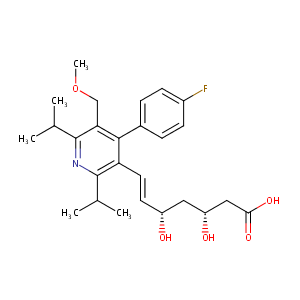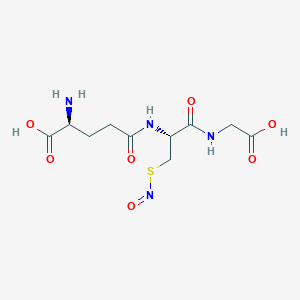| 1 |
Recurrent recessive mutation in deoxyguanosine kinase causes idiopathic noncirrhotic portal hypertension.Hepatology. 2016 Jun;63(6):1977-86. doi: 10.1002/hep.28499. Epub 2016 Mar 31.
|
| 2 |
URL: http://www.guidetopharmacology.org Nucleic Acids Res. 2015 Oct 12. pii: gkv1037. The IUPHAR/BPS Guide to PHARMACOLOGY in 2016: towards curated quantitative interactions between 1300 protein targets and 6000 ligands. (Ligand id: 2950).
|
| 3 |
Emerging therapies for multiple myeloma. Expert Opin Emerg Drugs. 2009 Mar;14(1):99-127.
|
| 4 |
Identification of the hepatic efflux transporters of organic anions using double-transfected Madin-Darby canine kidney II cells expressing human organic anion-transporting polypeptide 1B1 (OATP1B1)/multidrug resistance-associated protein 2, OATP1B1/multidrug resistance 1, and OATP1B1/breast cancer resistance protein. J Pharmacol Exp Ther. 2005 Sep;314(3):1059-67.
|
| 5 |
Mammalian drug efflux transporters of the ATP binding cassette (ABC) family in multidrug resistance: A review of the past decade. Cancer Lett. 2016 Jan 1;370(1):153-64.
|
| 6 |
FDA Drug Development and Drug Interactions
|
| 7 |
Differential effect of genetic variants of Na(+)-taurocholate co-transporting polypeptide (NTCP) and organic anion-transporting polypeptide 1B1 (OATP1B1) on the uptake of HMG-CoA reductase inhibitors. Xenobiotica. 2011 Jan;41(1):24-34.
|
| 8 |
pH-sensitive interaction of HMG-CoA reductase inhibitors (statins) with organic anion transporting polypeptide 2B1. Mol Pharm. 2011 Aug 1;8(4):1303-13.
|
| 9 |
Substrates, inducers, inhibitors and structure-activity relationships of human Cytochrome P450 2C9 and implications in drug development. Curr Med Chem. 2009;16(27):3480-675.
|
| 10 |
Cerivastatin, genetic variants, and the risk of rhabdomyolysis. Pharmacogenet Genomics. 2011 May;21(5):280-8.
|
| 11 |
Drug Interactions Flockhart Table
|
| 12 |
Role of cytochrome P450 2C8 in drug metabolism and interactions. Pharmacol Rev. 2016 Jan;68(1):168-241.
|
| 13 |
Cerivastatin, genetic variants, and the risk of rhabdomyolysis. Pharmacogenet Genomics. 2011 May;21(5):280-8.
|
| 14 |
Nitrosative stress response in Vibrio cholerae: role of S-nitrosoglutathione reductase. Appl Biochem Biotechnol. 2017 Jul;182(3):871-884.
|
| 15 |
The induction of reactive oxygen species and loss of mitochondrial Omi/HtrA2 is associated with S-nitrosoglutathione-induced apoptosis in human endothelial cells. Toxicol Appl Pharmacol. 2010 May 1;244(3):374-84. doi: 10.1016/j.taap.2010.02.004. Epub 2010 Feb 11.
|
| 16 |
Regulatory role of nitric oxide on monocyte-derived dendritic cell functions. J Interferon Cytokine Res. 2003 Aug;23(8):423-31. doi: 10.1089/107999003322277838.
|
| 17 |
Concentration-dependent effects of endogenous S-nitrosoglutathione on gene regulation by specificity proteins Sp3 and Sp1. Biochem J. 2004 May 15;380(Pt 1):67-74. doi: 10.1042/BJ20031687.
|
| 18 |
Induction of heme oxygenase-1 as a response in sensing the signals evoked by distinct nitric oxide donors. Biochem Pharmacol. 1999 Jul 15;58(2):227-36. doi: 10.1016/s0006-2952(99)00097-0.
|
| 19 |
Regulation of the hypoxia-inducible factor 1alpha by the inflammatory mediators nitric oxide and tumor necrosis factor-alpha in contrast to desferroxamine and phenylarsine oxide. J Biol Chem. 2001 Oct 26;276(43):39805-11. doi: 10.1074/jbc.M107689200. Epub 2001 Aug 20.
|
| 20 |
Studies on reduction of S-nitrosoglutathione by human carbonyl reductases 1 and 3. Chem Biol Interact. 2011 May 30;191(1-3):95-103.
|
| 21 |
Hypersensitivity of ataxia-telangiectasia fibroblasts to a nitric oxide donor. Free Radic Biol Med. 1997;22(1-2):343-7. doi: 10.1016/s0891-5849(96)00336-x.
|
| 22 |
The Janus face of alcohol dehydrogenase 3. Chem Biol Interact. 2009 Mar 16;178(1-3):29-35. doi: 10.1016/j.cbi.2008.10.050. Epub 2008 Nov 6.
|
|
|
|
|
|
|


